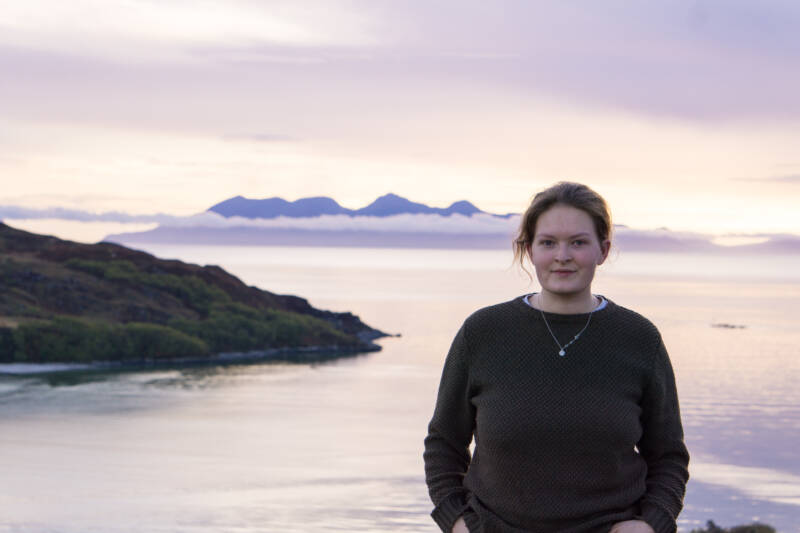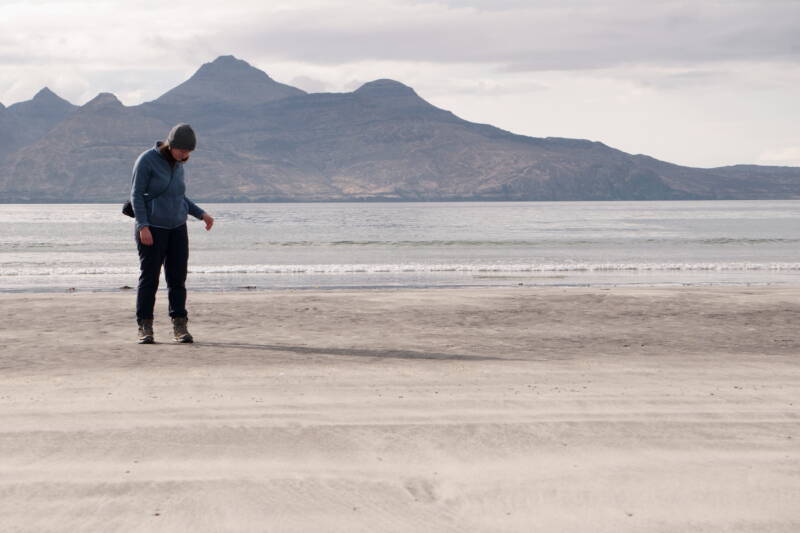Intrigued by the name of her new album, Helen Webster caught up with modern folk-singer, songwriter and storyteller Iona Lane to find out how the Scottish landscape inspires her music.

Congratulations on your debut album and the high praise it’s been receiving. It’s called Hallival after the mountain on the Scottish island of Rum and you’ve said that a lot of the songs stem from walks you have done thanks to Walkhighlands, can you describe how walking and the landscape inspires you and your music?
Thank you so much, it’s been an amazing journey so far and it’s wonderful to get this music out into the world. Most of my writing is inspired by natural landscapes and the stories that can be found in those places. My parents are big hill walkers and their love for the highlands has definitely rubbed off on me! I love walking hills and being out in the landscape, it’s the place I feel most human and alive. The most inspiring days are when I’m walking and I don’t see another person all day, it’s just me and the landscape, and normally a load of midgies for company.
Are there any specific days out or walks in Scotland that are particularly memorable for you?

Climbing Suilven a couple of summers ago was a highlight of mine. As children my parents took us to Assynt and Coigach a lot. We climbed a lot of the hills in the area; Canisp, Ben More Coigach, Sgùrr an Fhìdhleir, Cùl Beag, Quinag, Ben More Assynt, to name a few and, not going to lie, when I was a child I absolutely hated hill walking! With Suilven’s particularly long walk in we never climbed it as children so coming back and summiting it as an adult was super special. I remember getting to the top and having an overwhelming sense of achievement that felt like it had been in the works for many years. Haha, that being said, the feeling quickly disappeared when we started the big trudge back to Lochinver. It was a very special day for me and I will hold onto it fondly for a long time. I am actually about to record a new song, called ‘Suilven’, which was inspired by this day on the hill and that feeling of hating walking up hills as a child. It’ll be out in 2023!
How does the music writing process actually work for you?
When I’m out in the hills I’m absorbing the landscape, collecting folklore and enjoying being out and about! Walking brings me mental space to relax and is an escapism from the vast daily admin that comes with being a musician. It brings me peace and that’s when I can be most creative. The concepts and initial sparks for songs often come when I’m out in the landscape and I may write a few lyrics but the musical content tends to come to me later when I’m sitting with my guitar.

The main bulk of my writing happens when I take myself away to remote places to write. I’ve spent a fair amount of time writing in the Small Isles, mainly Rum and Eigg but also Muck. I take a few days to explore the islands and then I knuckle down to write! I’m yet to get over to Canna but I hope to visit as soon as I can! Achiltibuie also has a special place in my heart for writing, there’s something intrinsically beautiful about where the land meets the sea on the Scottish north west coast.
You’ve said that your song Mermaid is inspired by the folklore behind the building of Ardvreck Castle on the edge of Loch Assynt and that you spent a lot of time walking the hills of Assynt and Coigach as a youngster. Can you tell us a bit about this song and the area?
Mermaid is one of the oldest songs on the album, I wrote it back in 2018. It follows the tale of the building of Ardvreck Castle on the side of Loch Assynt. The Chief of the MacLeods runs out of money to finish the build and ends up marrying his daughter, Eimhir, to the devil, who offers to complete the work in exchange for marriage. Misled by her father Eimhir jumps from the tower of Ardvreck Castle into Loch Assnyt and is immortalised as a mermaid. The water level in Loch Assynt fluctuates and it’s believed that when the water begins to rise it’s due to the tears of Eimhir. I wrote this song for Eimhir, thinking about how a woman’s life was deceived by a man and sadly how she had to live with the consequences. Assynt is a glorious place! I love the area a lot and I look forward to going back as often as I can. The hills there, despite not being huge, are impressive and otherworldly.
Conditions can be brutal in Scotland sometimes – is there anything positive you’ve been able to take from a particular wet, claggy, midgie or just downright awful day in the hills?
Haha! Yes they can be! I suppose the thing I take away from days with particularly bad weather is isolation. I’ve been out in the hills in bad weather and not seen anyone else, apart from whoever I might be walking with. There’s something really beautiful about being somewhere that no one else is and bad weather and midgies often bring that. My favourite thing about terrible days on the hill are the stories that you end up taking home with you, whether that’s a bit of folklore I stumbled on or making memories with friends and family.
You chose to record the album on the Ardnamurchan peninsula. Why did you choose there, and do you feel it made a difference to the process and end result?
We recorded ‘Hallival’ at Watercolour Music, in Ardgour, just over the Corran Ferry. I wanted to record the album in a studio that felt like part of the landscape and put us in an environment that inspired a lot of the writing. Watercolour is in such a blissful spot, we recorded whilst overlooking Ben Nevis, copious amounts of deer and ever-changing spring weather – there was one day that we had rain, sleet, snow, sun and hail on repeat all day. I’m amazed we actually managed to record an album as I spent so much time looking out of the window. I hope that you can maybe hear the influence of the landscape in our playing!

Your song Schiehallion is inspired by an experiment on the mountain in 1774 when the density of the earth was calculated for the first time and from which the idea of contour lines on maps was born. Why were you drawn to this story and mountain? I was fascinated to learn that the scientists and locals had a drunken party at the end of their time on the mountain and ended up burning down the bothy – are you a fan of bothies or wild camping, what’s the ideal day out walking for you?
I actually can’t remember how I first came to hear about the Schiehallion Experiment. The thing that drew me to the story was the combination of science and folklore that you get with Schiehallion, there’s so much folklore tied up with that mountain as well as science. Apparently, the fiddle player at the party got so drunk they burnt their violin and the bothy to the ground. I thought this was an incredible end to the story and I just had to write about it! One of the locations for the music video was actually in a nearby bothy and I do love a good bothy and a wild camp! Guirdil on the Isle of Rum is my favourite bothy to visit, stunning views over to Canna and the beach is glorious. My ideal day’s walk would be anything that gets me out into a remote spot, ideally between the mountains and sea – that’s what I really love!
Hallival is available to stream and download or in CD or vinyl form, or on streaming services. https://ionalane.bandcamp.com/album/hallival

